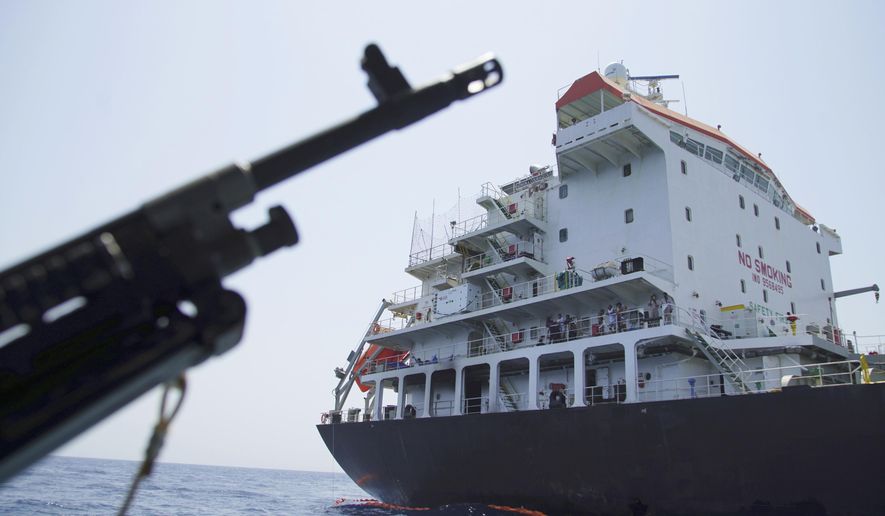The U.S. Navy shot down a “threatening” Iranian drone over international waters in the Strait of Hormuz Thursday, President Trump and Pentagon officials said, adding fresh fuel to already simmering tensions between the two nations.
Mr. Trump made the surprise announcement during an unrelated White House ceremony Thursday afternoon, saying that the USS Boxer was forced to destroy the drone after it ignored multiple orders to withdraw.
The incident instantly triggered memories of an Iranian shootdown or a massive U.S. surveillance plane last month that it claimed had strayed into its airspace last month. No one was killed, but Mr. Trump claimed at the time he called off a planned retaliatory strike on Iranian targets with just minutes to spare.
“This is the latest of many provocative and hostile actions by Iran against vessels operating in international waters,” Mr. Trump said Thursday. “The United States reserves the right to defend our personnel, facilities and interests.”
The Defense Department quickly confirmed the president’s comments and said the Iranian craft, whose size was not specified, had gotten dangerously close to the Navy ship.
“At approximately 10 a.m. local time, the amphibious ship USS Boxer was in international waters conducting a planned inbound transit of the Strait of Hormuz. A fixed-wing unmanned aerial system (UAS) approached [the] Boxer and closed within a threatening range,” Pentagon spokesman Jonathan Hoffman said. “The ship took defensive action against the UAS to ensure the safety of the ship and its crew.”
Iranian officials Thursday didn’t immediately address the downing of its drone, but Foreign Minister Javad Zarif told reporters in New York that the Trump administration is solely responsible for the escalating tensions between the two sides. Mr. Trump has re-imposed harsh sanctions on Iran’s economy and trade after withdrawing from the international nuclear deal signed with Tehran in 2015.
“We live in a very dangerous environment,” Mr. Zarif told reporters during a visit to the United Nations. “The United States has pushed itself and the rest of the world into probably the brink of an abyss.”
Meanwhile Thursday, Iran’s Revolutionary Guard released video of the seizure of a foreign oil tanker Iran said was illegally smuggling fuel out of the country. The video revealed the ship to be a United Arab Emirates vessel that disappeared in the area over the weekend.
The seizure heightened fears that Iran will respond to a U.S. effort to choke off its oil exports by interrupting the flow of fuel through the Strait of Hormuz, a key shipping channel. The U.S. also has accused Iran of being behind two limpet mine attacks on commercial oil vessels in recent months, though Tehran has denied involvement.
The continued tensions come even as the Trump administration seeks negotiations with Iran over its nuclear ambitions. Tehran over the past month has begun to disregard major aspects of an Obama-era deal limiting its nuclear weapons program, including exceeding the limit on uranium stockpiles and enriching uranium beyond the thresholds laid out in the multinational pact.
The White House has maintained that it is willing to talk with Iran but that Tehran must first cease its pursuit of nuclear weapons, end financial support for terrorism, and take a host of other steps. Iran has said it will consider talks with the U.S. only if Washington drops the new sanctions and rejoins the 2015 deal Mr. Trump abandoned.
Regional specialists say Thursday’s drone shootdown could be the result of Iran’s continued campaign to sow enough chaos in the region that the U.S. is forced to make concessions and ease its economic pressure campaign on Tehran.
“America’s defensive action against continued Iranian harassment does not mean further military escalation is imminent,” said Behnam Ben Taleblu, a senior fellow at the Foundation for Defense of Democracies. “Iranian harassment by drone, which has been growing in international waters, is part of the regime’s low-cost, risk-tolerant asymmetric warfare strategy.”
• Dave Boyer can be reached at dboyer@washingtontimes.com.
• Ben Wolfgang can be reached at bwolfgang@washingtontimes.com.




Please read our comment policy before commenting.